I hate to be the bearer of bad news to all my fellow stomach sleepers, but ladies and gentlemen: We’re doing things all wrong. Any sleep pro will tell you that your stomach is the worst possible position for your body to spend its sleeping hours in, and, unless you’ve got one of the best pillows for stomach sleepers in your arsenal, you’re setting yourself up for some serious discomfort during the day.
“Sleeping on your stomach poses several risks, including potential back pain and strain on the spine, which can affect other areas of the body,” says Martin Seeley, senior sleep expert at the UK-based sleep brand MattressNextDay. “Additionally, this position may restrict the airways, making it difficult to breathe comfortably.”
Experts In This Article
But if knowing this doesn’t dissuade you from cozying up face-down (I, for one, have zero plans to change my ways), investing in a proper pillow is key to keeping your body comfortable during waking hours. “The right pillow—and its placement—can help mitigate some of these risks,” confirms Seeley.
Buying a new pillow is a whole lot easier than training your adult body to sleep in an entirely new position, and we’ve got you covered with seven options that ensure you’ll never have to.
In This Article
Best pillows for stomach sleepers at a glance:
- Best overall: Bluewave Bedding, Hyper Slim Gel Memory Foam Pillow for Stomach and Back Sleepers, $40
- Best memory foam: Panda, Luxury Memory Foam Bamboo Pillow, $70
- Best down pillow: Brooklinen, Down Pillow, $93
- Best hypoallergenic: Boll & Branch, Down Alternative Pillow, $89
- Best for neck pain: Cozyplayer, No More Aches Neck Pillow, $40
- Best cooling pillow: Belly Sleep, The Belly Sleeping Pillow, $40
- Best for combination sleepers: Marlow, The Pillow, $65
What kind of pillow should a stomach sleeper use?
When it comes to finding the best pillow for belly sleepers, there are a few different factors to consider:
1. Size
In this case, size matters. “If you’re sleeping with a pillow that is the wrong size for you, your neck won’t be able to sit in a neutral position, which means your head is going to rest too far in one direction toward either shoulder,” says Jeff Brannigan, director of programming at the NY-based stretch and recovery space STRETCH*D. “Over time this will create misalignment in the spine and negatively impact your posture.”
To avoid stressing out the spine, the smaller your stomach sleeping pillow, the better. “Stomach sleepers typically benefit from thinner pillows to prevent neck strain and maintain a neutral spine position,” says Seeley. He recommends looking for a “low loft” pillow that’s three inches thick or less.
2. Firmness
A too-tough pillow can lift your head higher off the mattress than it should be and amplify the unnatural curvature in your spine, which is why Seeley suggests opting for something with soft-to-medium firmness. “This will provide enough support without elevating your head too much,” he says.
If soft pillows aren’t your jam, both pros note that memory foam is also a great option. “Memory foam pillows can work well for stomach sleepers because they offer support and comfort by molding to your head and neck,” says Seeley. “Just keep their breathability and adjustability in mind to find the right fit for you.”
3. Materials
To strike this perfect balance of firmness and size, you’ll want to invest in a pillow that’s made with quality materials. If you’re dealing with back pain, Shelby Harris, PsyD, director of sleep health at Sleepopolis, suggests looking for soft pillows filled with down (or a down alternative), which are flexible enough to allow your head to melt into them and avoid aggravating your spine. If you’re dealing with neck pain, a contouring fill—like memory foam or shredded memory foam—is the best bet, as these materials offer a bit more loft and support.
Additionally, Harris recommends opting for breathable cover fabrics (like cotton or silk) and hypoallergenic materials, which are less likely to trigger the skin and allergy reactions that are common among stomach sleepers.
7 best pillows for stomach sleepers
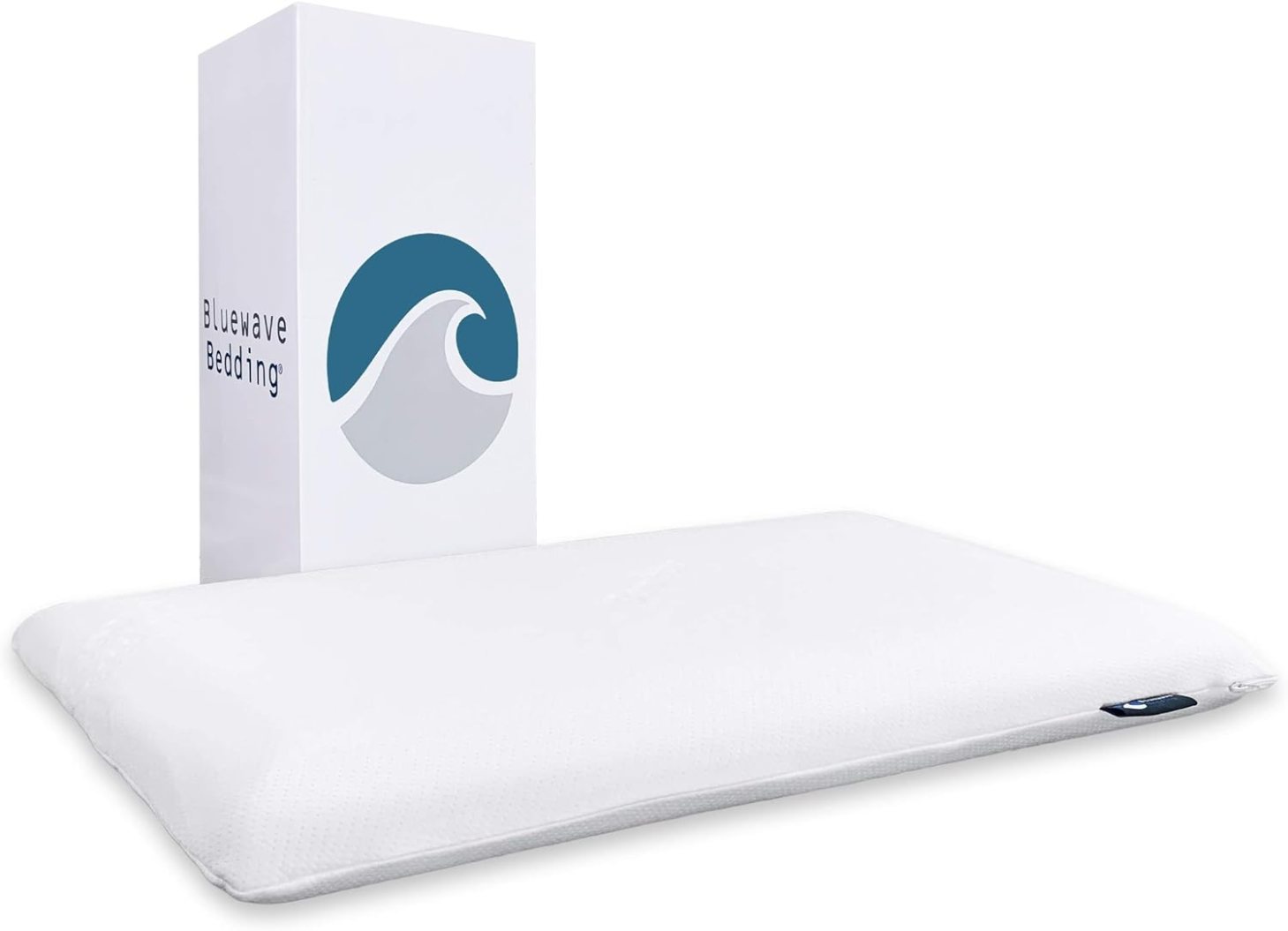
Best overall: Bluewave Bedding, Hyper Slim Gel Memory Foam Pillow for Stomach and Back Sleepers — $40.00
Available sizes: King, Standard
Fill: Ventilated gel memory foam
This stomach sleeper-friendly pillow checks all the recommended boxes: Low loft, fill that contours to the shape of your head and neck, and hypoallergenic materials. What sets it apart from our other selects—and has earned it the “best overall” spot—is that there are three different loft, or height, options to choose from, each of which is under the threshold that Seeley recommends for sleeping on your stomach. All of the pillows are made with the brand’s ventilated, moisture-wicking memory foam, but hot sleepers may want to invest in one of the “Max Cool” styles (available in all sizes) that come with the added bonus of being coated with CarbonBlue cooling coating.
Available lofts: Hyper Slim (2.5″H), Ultra Slim (2.75″H), Super Slim (3.25″H)
Firmness: Medium
Cover material: 60% polyester, 40% bamboo-derived rayon
Care instructions: Machine washable cover
- Multiple low loft options to choose from to find your perfect fit
- “MaxCool” styles available for hot sleepers
- Machine washable cover
- Affordable
- May initially have that “new memory foam” smell

Best memory foam: Panda, Luxury Memory Foam Bamboo Pillow — $70.00
Available sizes: 23″ x 16″
Fill: Memory foam
This pick comes straight from Seeley who recommends memory foam for stomach sleepers thanks to its ability to mold to the shape of your head and neck. “The pillow will shape to your head and neck is perfect for keeping your spine supported and could reduce neck and back pain in the morning,” he says. “It’s not only award-winning, but it’s super breathable, has antibacterial properties, and comes with a built-in cooling system to ensure you don’t overheat.”
Available lofts: 4.7 inches
Firmness: Medium
Cover material: Bamboo-derived rayon
Care instructions: Unspecified
- Hypoallergenic
- Comes with a built-in pillow protector
- Eco-friendly
- Returnable after a 30-day trial
- Affordable
- May be slightly too thick for some stomach sleepers
- Only available in one size that’s slightly smaller than a standard pillow
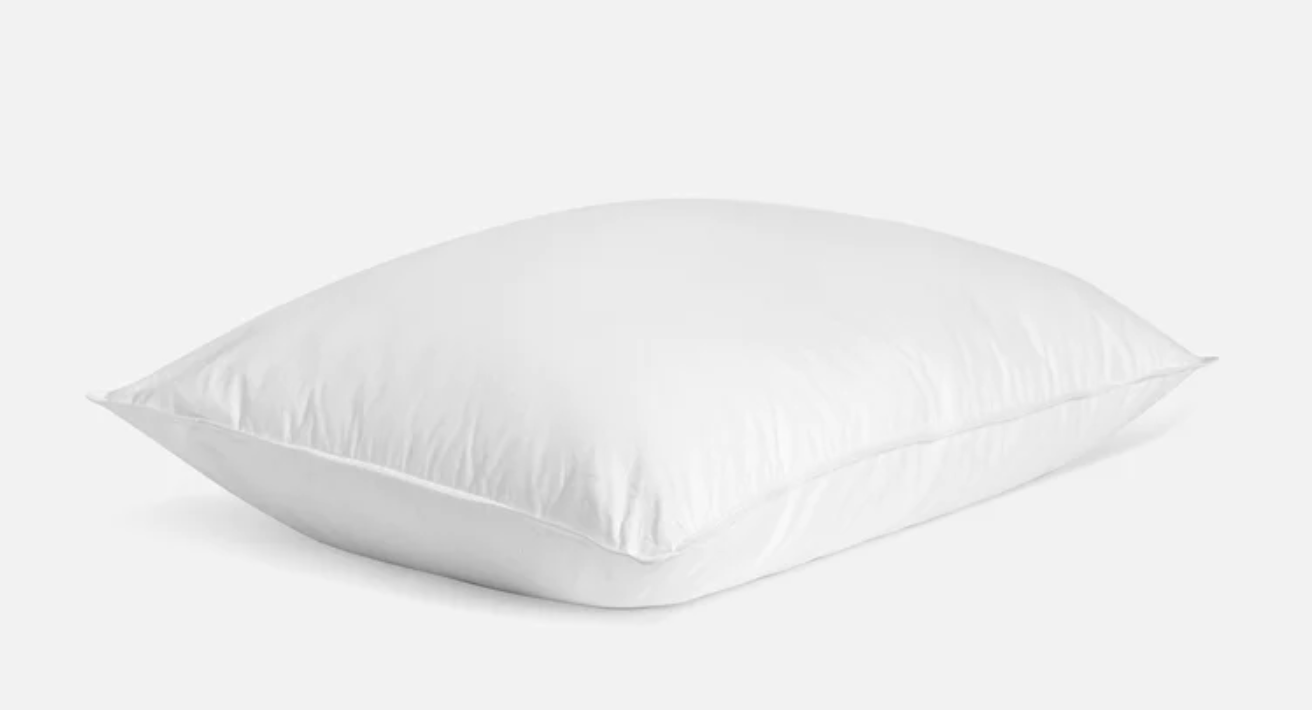
Best down: Brooklinen, Down Pillow — $93.00
Available sizes: Standard, King
Fill: 100% down clusters and feathers
Brooklinen’s Plush pillow (the least-firm option on offer from the brand) will leave you feeling like you’re sleeping on a cloud—it’s that soft. It’s made exclusively from goose down clusters, which are softer than feathers and make the pillow malleable enough that your head will sink straight into it (in a good way!), and the cotton sateen cover is luxe and breathable.
Available lofts: Plush (recommended for stomach sleepers), Mid-Plush, Firm
Firmness: Soft, medium, firm
Cover material: 100% cotton sateen
Certifications: DOWNMARK® Certified
Care instructions: Unspecified
- Hypoallergenic
- Antibacterial
- Made from super-soft down clusters
- Plush and moldable
- Does not offer support for those with neck or back pain
- Uses an animal byproduct, which may be a con for some shoppers
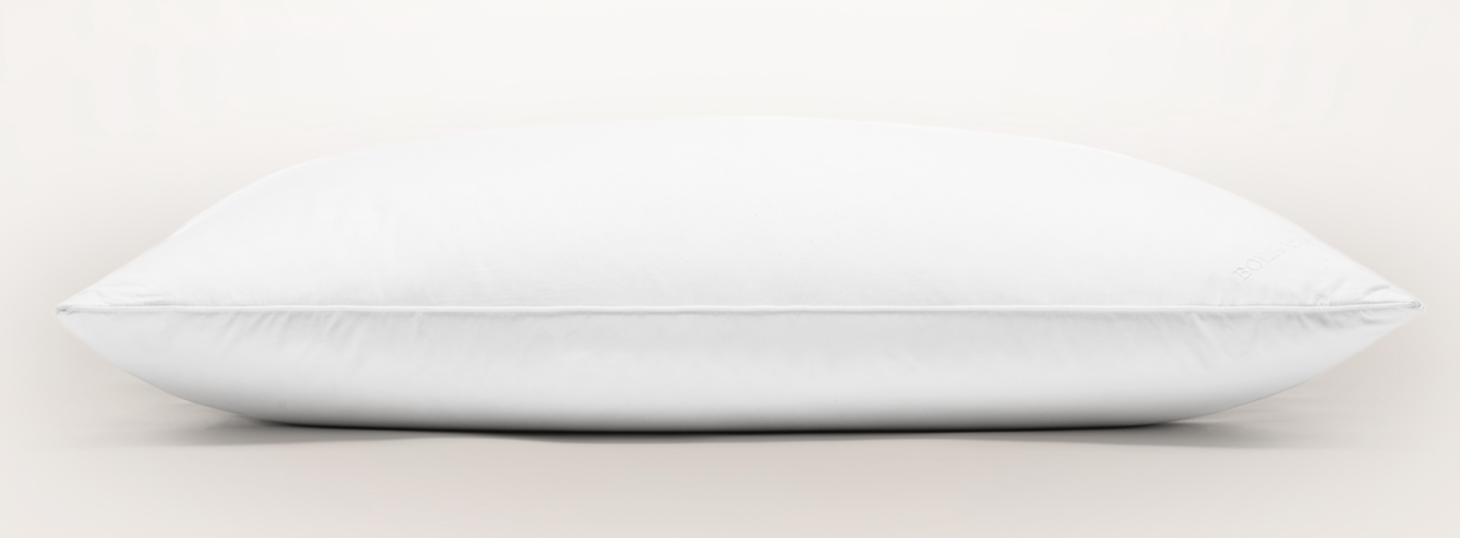
Best hypoallergenic: Boll & Branch, Down Alternative Pillow — $89.00
Available sizes: Standard, King
Fill: Primaloft down alternative
This down-alternative pillow is so plush, you’d swear it was the real thing. It’s available in three different loft/firmness combinations, but per usual, stomach sleepers should opt for the lowest-loft “soft” option for optimal comfort. Arguably the best thing about it is that, unlike the other pillows on this list, you can toss this one straight into the washing machine without having to worry about the insides getting all wonky. Night sweaters, rejoice.
Available lofts: Low, medium, high
Firmness: Soft, Medium, Firm
Cover material: 100% organic cotton
Care instructions: Machine washable pillow and cover
- Hypoallergenic
- Machine washable
- Multiple loft/firmness options available
- Made with eco-friendly down alternative
- Plush and moldable
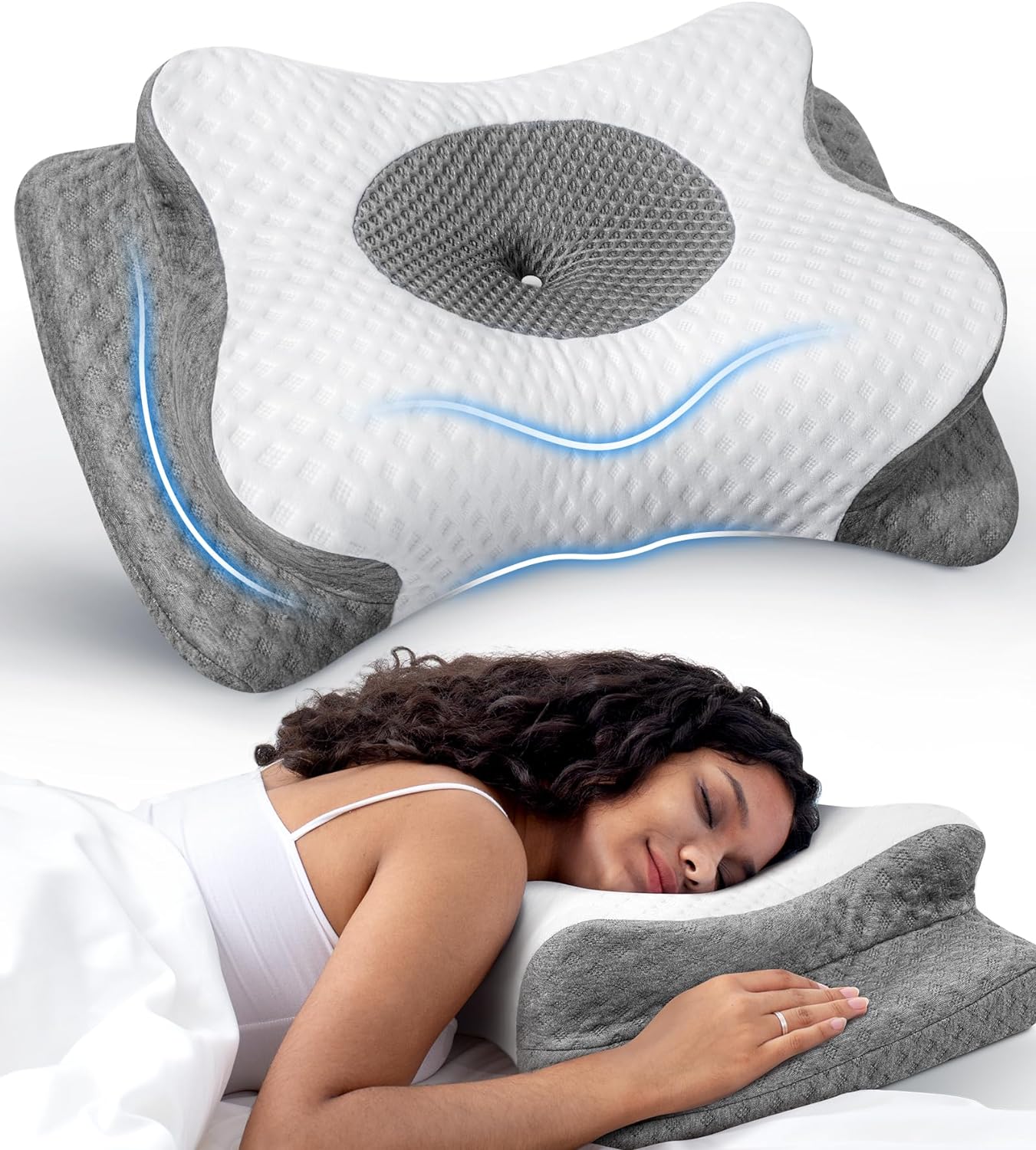
Best pillow for neck pain: Cozyplayer, No More Aches Neck Pillow — $40.00
Available sizes: 15.5″ x 6.5″ x 6.5″
Fill: Memory foam
When you’re dealing with neck pain, Seeley recommends an ergonomic pillow with contouring or cervical support to maintain proper spinal alignment, and this one fits the bill. It’s made with memory foam, which we already know is great for stomach sleepers, and its unique butterfly design comes with a center cavity for you to put your head in and an arched cervical support area that goes under your neck.
It’s also got two armrests that allow you to comfortably stick your arms under your pillow—and, as such, make it easy for your partner to spoon you without the weirdness of trying to figure out where they should put their bottom arm. Additionally, the loft is adjustable, and the brand recommends removing the 0.8-inch piece of memory foam at the bottom of the pillow to make it the perfect height for sleeping on your stomach.
Available lofts: Adjustable
Firmness: Firm
Cover material: Unspecified
Care instructions: Washable cover
- Adjustable loft
- Equipped with a head cavity, armrests, and neck and shoulder support
- Affordable
- Memory foam is not organic, and may initially come with a chemical-y smell
- Does not fit with standard pillowcases
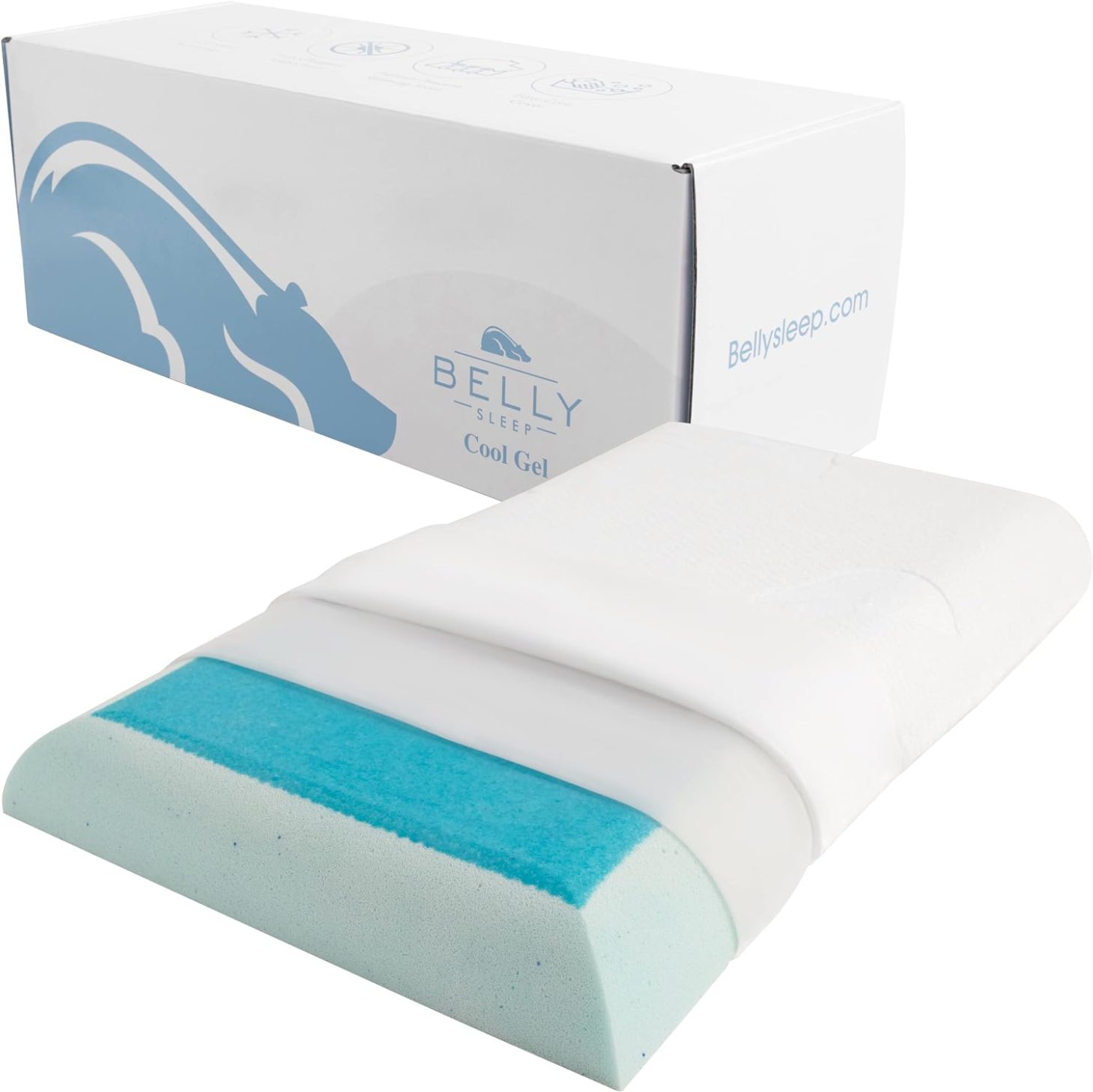
Best cooling: Belly Sleep, Belly Sleeper With Cool Gel Topper — $60.00
Available sizes: Mini, Standard
Fill: Gel Tech Memory Foam
As you may have guessed from the name, this cooling pillow was designed specifically with stomach sleepers in mind. It’s ultra-thin (an impressive 2.5 inches), and will get your head as close to the mattress as humanly possible while still offering some support. Traditional memory foam tends to trap heat, but The Belly Sleeping Pillow is made with a special polyurethane foam and topped with a temperature-regulating cooling gel to keep you from overheating.
Available lofts: 2.5″
Firmness: Firm
Cover material: 60% bamboo, 40% polyester
Care instructions: Machine washable cover
- Very low loft that’s perfect for stomach sleepers
- Enclosed in a breathable bamboo cover
- Equipped with heat-releasing memory foam and topped with cooling gel
- Hypoallergenic
- Available in a mini size for travel or placing under your chest
- May trap moisture
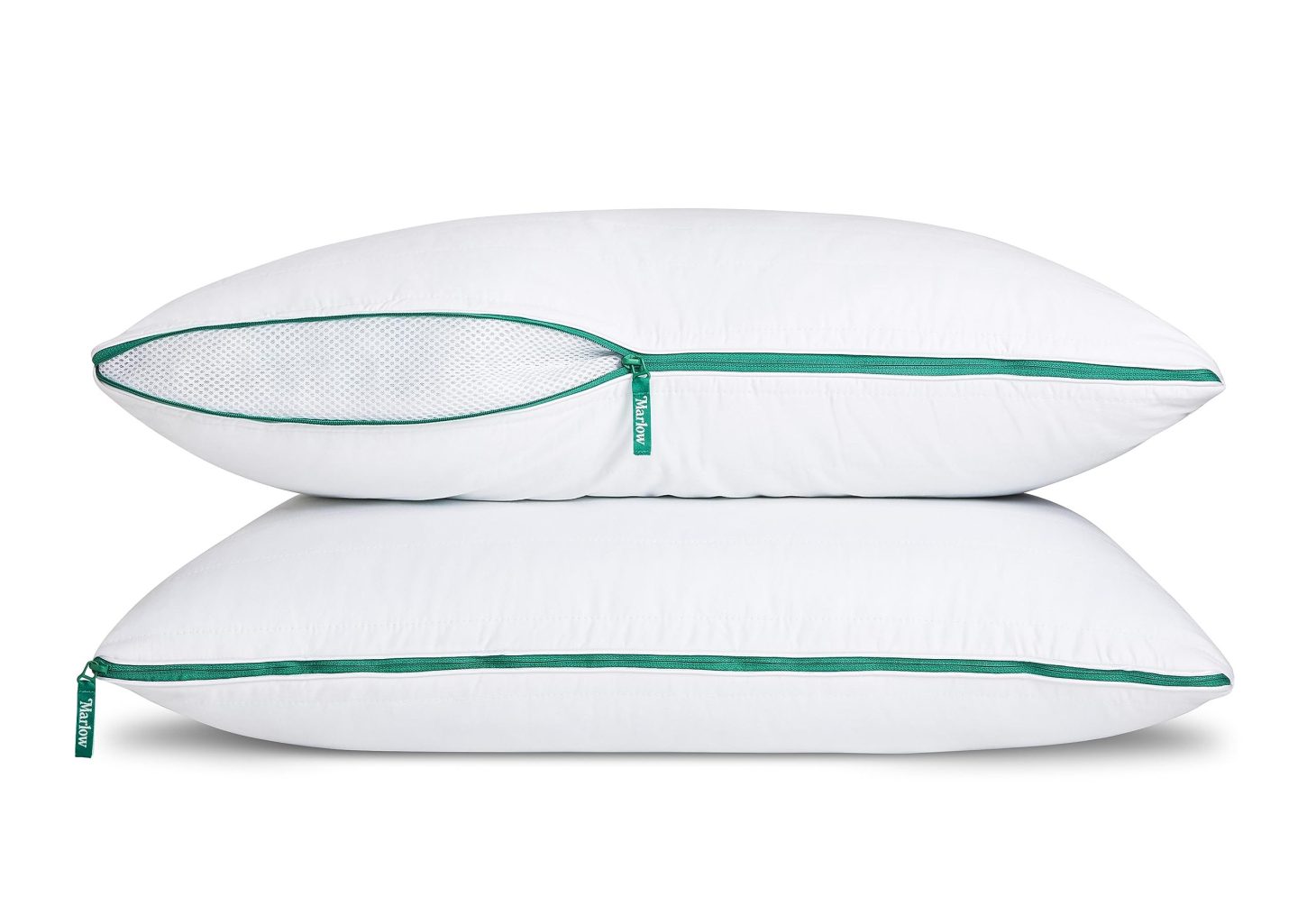
Best for combination sleepers: Marlow, The Pillow — $65.00
Available sizes: Standard, King
Fill: Gel-infused memory foam
For $65, Marlow delivers three pillows for the price of one, making this the perfect pick for “combination sleepers” who switch their positions (so, most people). It’s got a zipper on three sides that allows you to customize the height and firmness: Stomach sleepers should unzip it to its thinnest level, side sleepers should leave one side zipped for a medium-loft option, and back sleepers should keep it totally closed for maximum thickness.
Available lofts: Adjustable (low to high)
Firmness: Adjustable (soft to firm)
Cover material: Sateen
Care instructions: Spot treat only
- Adjustable height and firmness
- Filled with cooling memory foam
- Antimicrobial
- Not machine washable
Where do you put a pillow when sleeping on your stomach?
Just as important as the pillow itself is where you put it while you’re sleeping, and you’ve got a few different options to choose from
To avoid neck and shoulder pain
“I urge stomach sleepers to place pillows under their head and shoulders,” says Seeley. Shimmying up so that your shoulders are supported will help you maintain a more neutral spinal position, lowering your risk for back and neck discomfort.
To help with breathing
To avoid some of the airway constriction that comes with sleeping on your stomach, Seeley suggests ditching your usual Queen- or King-sized pillow in favor of something travel-sized. “Placing a small pillow under the chest or forehead can improve breathing and make stomach sleeping more comfortable,” he says.
To minimize lower back discomfort
If sleeping on your stomach leaves your lower back feeling not-so-great, the pros recommend taking a totally different approach to pillow placement. “Stomach sleepers may benefit from placing a thin pillow under their pelvis to prevent lower back strain,” says Seeley. “Opting for a thin pillow—or even no pillow—under the head can reduce strain on the neck and maintain a more neutral spine, and placing a pillow under the pelvic can support the lower back.”
But, really, if you’re waking up in pain, a pillow likely isn’t going to fix the problem—you may want to start training yourself to remix the way your body likes to rest.
FAQs
What is the healthiest sleeping position?
While the “best” sleeping position is the one that will ultimately deliver eight uninterrupted hours of snooze time, certain setups are better for your overall health than others—and stomach sleeping ranks at the bottom of the bunch.
For starters, sleeping on your stomach forces your spine into a backward curve, which places undue stress on your neck and back. Plus, the fact that you’re likely turning your head all night to avoid a faceful of pillow doesn’t help. “Keeping your head rotated in an end range for a long period puts strain on the muscles and vertebral joints,” Mallory Behenna, DPT, an orthopedic physical therapist at Brooks Rehabilitation, previously told Well+Good.
In addition to these spine-related issues, stomach sleeping may cause difficulty breathing and expose you to more of the allergens in your bedding, which can cause congestion, says sleep specialist and clinical psychologist Michael J. Breus, PhD, chief sleep advisor at Purple. And unless you’re sleeping on skin-friendly silk, spending eight hours with your face pressed into a pillow may cause wrinkles to form over time. Though some people may find stomach sleeping helpful for digestion and snoring (a definite bonus for couples), the pros agree that these benefits don’t necessarily outweigh the risks.
With that in mind, “the healthiest sleeping position is usually sleeping on your back because it keeps your spine aligned and eases pressure on your neck and back,” says Harris. Side sleeping—ideally with a pillow between your knees—is your second-best option.
But if you’ve spent years snoozing on your stomach, changing things up may be far easier said than done: Your body has likely developed “muscle memory” and will naturally fall back into its favorite position knowing it promises a good night’s sleep.
Thankfully for those of us who can’t kick our stomach sleeping habits, all of this comes with an important caveat. “It all really depends on what feels best for you—the key is to wake up feeling rested and pain-free,” says Harris. And as long as you’ve got the right pillow, that’s entirely possible without having to flip your go-to position.
How often should you change your pillows?
Most experts recommend changing your pillow every 1-2 years. Over time, pillows accumulate dust mites, allergens, and moisture, diminishing their support and hygiene. Regular pillow replacement ensures continued comfort and supports a healthier sleep environment.
Our editors independently select these products. Making a purchase through our links may earn Well+Good a commission.
Source: Well and Good






